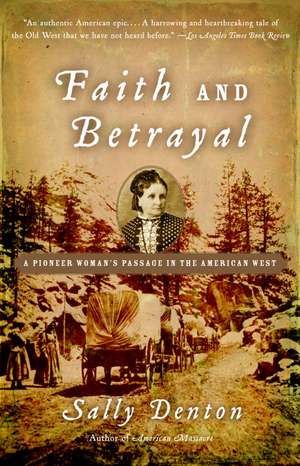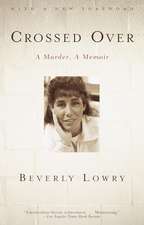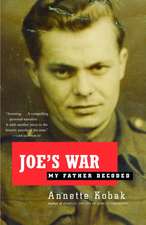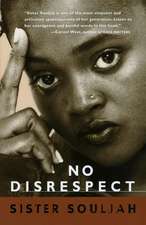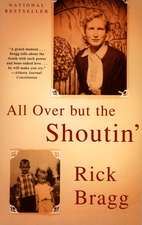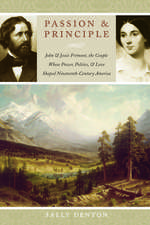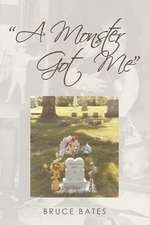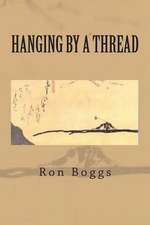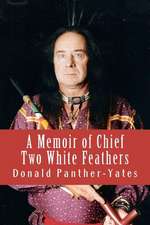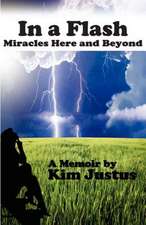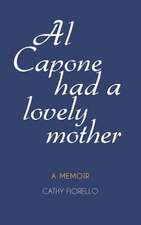Faith and Betrayal: A Pioneer Woman's Passage in the American West
Autor Sally Dentonen Limba Engleză Paperback – 30 iun 2006
Preț: 107.68 lei
Nou
Puncte Express: 162
Preț estimativ în valută:
20.61€ • 22.38$ • 17.31£
20.61€ • 22.38$ • 17.31£
Carte disponibilă
Livrare economică 01-15 aprilie
Preluare comenzi: 021 569.72.76
Specificații
ISBN-13: 9781400034734
ISBN-10: 1400034736
Pagini: 216
Ilustrații: 10 ILLUSTRATIONS ; 1 MAP
Dimensiuni: 134 x 206 x 16 mm
Greutate: 0.25 kg
Editura: Vintage Books USA
ISBN-10: 1400034736
Pagini: 216
Ilustrații: 10 ILLUSTRATIONS ; 1 MAP
Dimensiuni: 134 x 206 x 16 mm
Greutate: 0.25 kg
Editura: Vintage Books USA
Notă biografică
Sally Denton is the author of American Massacre: The Tragedy at Mountain Meadows, September 1857; The Bluegrass Conspiracy: An Inside Story of Power, Greed, Drugs, and Murder; and, with Roger Morris, The Money and the Power: The Making of Las Vegas and Its Hold on America, 1947--2000. She received Western Heritage Awards in 2002 and 2004, a Lannan Literary grant in 2000, and, for her body of work, the Nevada Silver Pen Award of 2003 for distinguished literary achievement. Her award-winning investigative reporting has appeared in the New York Times, the Washington Post, and American Heritage. She lives with her three children in New Mexico.
Extras
Chapter One
“Worth a Long Walk to See”
September 23, 1873. Jean Rio delivers the Ayer baby girl at five-fifteen p.m., after a relatively easy labor, and the mother sleeps quietly for the next several hours. “Had a good night,” Jean Rio records in her midwife’s notebook. (“The baby grows nicely [and] all seemed to enjoy themselves,” she notes nearly a month later, after the mother brings the newborn and the rest of her children to pay a visit.)
It is not always as easy as it might seem. Even the uncomplicated births like Mrs. Ayer’s are trials, the mother usually moaning and screaming in desperation through a long, painful labor to the final agony and then the sudden release of delivery. Often there are tests and horrors Jean Rio must face and somehow cope with, using only her hands and her self-taught skills, experience, and inherent fortitude—hemorrhaging or mortally ill mothers; distressed, deformed, or stillborn babies—a bloody life-and-death struggle no less of a test than any battle faced by a man.
When she cleans up afterward, changing one plain dress—now stained—for another, washing the blood and afterbirth from her hands and arms, she removes her rings, a fine gold band and an exquisite small sapphire set in platinum. They are hardly the rings of a hardworking midwife on the raw California frontier of the late nineteenth century. She might seem a plain, even ordinary, woman of her time and place. But the unexpected grace and beauty of the rings match her own dignity and gentility. The rings signal that she is something other than an ordinary woman.
In her diary entry for October 23, she allows herself one of the rare references these days to the past that the rings echo. “Clear and lovely as a spring morning in England,” she writes. “This summer was worth a long walk to see.” How long a walk it has been, what a dramatic journey full of trust and betrayal, faith and disillusion, defeat and triumph, loss and gain! None of her new friends and neighbors in this rural hamlet can imagine it.
Only the rings and her obvious refinement and intellect, partially obscured by her unpretentious bearing, give a hint of the stark contrast between her past and present. Once she wore the finest gowns of European couture—a wardrobe so vast it had taken nearly an entire wagon to transport. Here she dresses in homespun. Once she performed the classics of song on the stages of Paris and London. Now she performs the exhausting rites of life and death, work no woman of her former station would have deigned to do. Most dramatically, once she was a prize convert to a powerful faith. Now she lives as a discreet fugitive from the betrayal of all that brought her here.
Chapter Two
A Wine Cask on the Channel
Tumbrils filled with entire families rolled along the cobblestone streets of Paris toward the guillotine amid howls and screams. All day, every day during 1792, the killing device was busy, corpses piling up faster than they could be disposed of. More than forty thousand people went to their deaths in those small carts. The decapitation was swift, taking less than half a second from the blade drop to the rolling head—the guillotine was “an instrument adopted by the Revolutionists for the more scientific and humane beheading of the condemned.” Almost all the members of the Rio family from Lamballe, Brittany—renamed Côtes-du-Nord by the revolutionary government—were among them. “Hourly, the hideous instrument of torture claimed its many victims—old men, young women, tiny children—until the day when it would finally demand the head of a King and of a beautiful young Queen,” as one fictional account put it.
Entire generations were eliminated, as victims of all ages were placed facedown on a bench. “The mechanism falls like lightning; the head flies off; the blood spurts; the man no longer exists,” Dr. Joseph-Ignace Guillotin once explained to a nervous audience. The instrument, however, wasn’t always that efficient.
Many of the Rios, like thousands of others, had tried to flee—to England, Belgium, Scotland, Holland, Canada, or the United States. At least one small Rio girl would be delivered from the bloodbath.
In Paris in the summer of 1789, during the earliest phase of the French Revolution—the “Great Fear”—a manservant long devoted to a wealthy French couple from the Rio clan placed their infant daughter in a wine cask. Thus concealed, the baby was smuggled across the English Channel. Her parents and every known family member are believed to have stayed behind, and to have become victims of the revolutionists. Once in England, the guardian christened his tiny refugee with the name Susanna Ann Burgess while providing her with protection in a new land. The fabricated surname, according to family lore, denoted the bourgeois roots of her family, though the reality no doubt was more complicated. The two made their way to Scotland, to the Isle of Skye, where relatives and royalist sympathizers embraced the child. They remained in hiding as the London society press regularly reported on new arrivals from France. The English response to the events taking place across the Channel vacillated between horror and sympathy, trepidation at the infectious revolutionary spirit, and base curiosity.
Susanna would spend her childhood and adolescence in Scotland, her guardian impressing upon her a deep hatred of all things French. This was the story Jean Rio told her children and grandchildren about her French and Scottish ancestors and her mother’s flight from persecution to freedom. She apparently never imparted information about the origins of her own middle name, Rio, perhaps embarrassed by the aristocratic association.
At the time of the revolution, France was the wealthiest and most powerful nation in the world. Its society was divided into three classes. The First Estate—the clergy—controlled the press, monopolized religion, governed the educational institutions, and owned the choice land. The Second Estate consisted of the nobility, who were exempt from taxation but held all high government positions. The Third Estate was the class that encompassed the remaining 98 percent of the population and included the bourgeoisie, the proletariat, and the peasantry. Judging from Susanna Burgess’s entrée into elite, if not noble, society in Scotland, her parents were most likely either nobility or part of the educated upper middle class that sympathized with the Second Estate rather than the masses. With the Third Estate uprising on July 14, 1789, which destroyed the Bastille prison, symbol of royal tyranny, nobles and members of the upper bourgeoisie fled for their lives. The early-twentieth-century novelist Baroness Emmuska Orczy immortalized the flight in The Scarlet Pimpernel: “Men in women’s clothes, women in male attire, children disguised in beggars’ rags. In various disguises, under various pretexts, they tried to slip through the barriers, which were so well guarded by citizen soldiers of the Republic.”
Susanna would be one of thousands of French émigrés to England during the last decade of the eighteenth century, a time when open boats laden with refugees often navigated the stormy Channel in darkness. Many, like Susanna, were babies entrusted by their doomed parents to lowly retainers who had no price on their heads. “The English never ceased to wonder at the degree of devotion manifested by the servants of the French émigrés, greatly admiring their unalterable attachment to their masters,” according to a twentieth-century British scholar of the period. While the identity neither of the servant nor of Susanna’s parents is known, it is assumed her parents and all of her siblings were executed during the Reign of Terror, which started less than two years after Susanna’s flight to Scotland. When Napoléon rose to power a decade later and announced he would welcome back his nation’s exiles, Susanna and her guardian chose not to return.
The themes inherent in Susanna’s escape from Jacobin France would eerily be echoed in her daughter Jean Rio’s life: privilege, persecution, flight, liberation, and concealment. Susanna was born into a family of privilege and forced to escape when the social order collapsed. Jean Rio was moved to flee by a different kind of oppression, what she saw as spiritual bankruptcy. In the end, they both found refuge in hiding.
In 1809, at the age of twenty, Susanna Ann Burgess married a well-to-do Scotsman named John Walter Griffiths, four years older than she and descended from Scottish aristocracy. John’s father could trace his roots back several generations in London, with family christenings and marriages recorded for centuries at the same historic church. John’s mother, Jane Rio MacDonald, was of the landed-gentry MacDonald clan on the Isle of Skye, the MacDonalds having arrived in Scotland from the southern Hebrides in the thirteenth century. Her middle name would seem to indicate a relationship through blood and class lines to Susanna’s French family. In 1790 Lord MacDonald, either a brother or a cousin to Jane Rio MacDonald, built Armadale Castle on his 200,000-acre Highland estate, where the famous Scottish Jacobite Flora Macdonald had
married and where, in 1746, she had hidden Prince Charles Edward, Bonnie Prince Charlie, from Hanoverian troops. “With a price of thirty pounds on his head, he [Prince Charles Edward] wandered hungry and sick from one sanctuary to another, endangering everyone who gave him shelter,” one historian wrote. Flora Macdonald disguised him as an Irish maidservant and facilitated his escape to the mainland. The MacDonalds’ political and social circles included such luminaries as Samuel Johnson and James Boswell, indicating that John Griffiths was born and bred in a lofty world.
While a scion of Scottish nobility like John Griffiths might have fallen in love with and wed the supposed daughter of a fugitive French servant, the class lines and social conventions of the time make such a match highly improbable. The conjecture of genealogists and descendants rests on the more likely scenario that John and his distinguished family recognized Susanna as an aristocratic orphan and political refugee, if not a distant Rio cousin. All involved would have kept such a fact discreetly concealed in the still-charged atmosphere of the Napoleonic years, when escapees from the guillotine might still be prey to some settling of old scores.
The patrician Rio family dated back to the late sixteenth century in the renamed Côtes-du-Nord. Sparsely populated by nobles, priests, and peasants, the region was virtually devoid of the rising middle class. Its inhabitants were passionately loyal to the Catholic monarchy, an antirevolutionary stronghold. Entrenched Catholicism dating back to the fourth century fueled a zealotry and isolationism that kept the nobility out of touch with the object of the revolution. The area would come to symbolize some of the most ruthless reprisals and cold-blooded massacres perpetrated by the revolutionaries. “The worst excesses were committed in the provinces,” historian Christopher Hibbert writes of the bloodshed. “In several towns the guillotine was kept constantly at work and those convicted of crimes against the Revolution were slaughtered wholesale.”
The Rio family had greatly diminished by the end of the eighteenth century, and in the nineteenth century only a handful of Rio births were recorded in France. The name became so rare that it could soon be traced only to an extremely wealthy Rio clan in rural Chard, England, and to the family of Susanna Burgess’s new mother-in-law on the Isle of Skye. Genealogical records and documents relating to Susanna Burgess give her birthdate only as “about 1788” and contain no further details as to place of birth, baptism, or pedigree.
When, on May 8, 1810, Susanna gave birth to her only child, she chose an anglicized spelling for her daughter’s name—Jane instead of the French Jeanne. Eventually the name would become Jean. The Rio name, pronounced with a long i and sometimes spelled “Rioux,” would be carried forward when Jean Rio’s firstborn son would include the name in that of each of his eight children.
John and Susanna’s daughter, Jean Rio Griffiths, would be baptized in London at the St. Lawrence Jewry, an impressive structure built in the twelfth century and dedicated to the martyr who had been roasted alive on a gridiron in third-century Rome. Rebuilt in 1670 by the great English architect Sir Christopher Wren, it was adorned with gold-leaf chandeliers, Grinling Gibbons carvings, and a window commemorating its pre-Reformation preacher, the martyred St. Thomas More. The rituals performed in this imposing edifice, a flagship of the Anglican establishment, would shape and dominate the first forty years of Jean Rio’s religious and spiritual life.
Jean Rio was born near the Jewry, in the district where William the Conqueror had relocated Jews in the eleventh century, and she would grow up an only child in the neighborhood of the Jewry and in the shadow of London’s Guildhall, the center of city government since the Middle Ages and during her lifetime a massive library. Though an intellectual life was largely reserved for males in the England of her youth, Jean Rio’s prosperous parents—both highly educated—afforded her every opportunity for learning. Professors of music came to their home to teach her to play the harp and the piano. She was granted an early education and she became an avid reader at a time when girls of her class were ridiculed for intellectualism. “As a rule, when girls had left school they were thought to be wasting time if seen reading,” wrote one of Jean Rio’s British contemporaries. “They were allowed to spend their superfluous energy in fancy work, and ridiculous wax-flower making, without molestation; but ‘put down your book,’ and ‘don’t waste your time that way,’ were common expressions.” Perhaps owing to her parents’ Scottish ancestry, books were a valued part of Jean Rio’s life. Early on, “reading and writing became embedded in Scottish society,” according to historian Arthur Herman. In Edinburgh “there were six publishing houses in 1763, for a city with a population of only sixty thousand.” She was educated in the English classics and had the good fortune to live at a time when four of the greatest British novelists were women. The fictional spheres of Jane Austen, George Eliot, and Emily and Charlotte Brontë were representative of Jean Rio’s own rarefied world.
Unlike reading, music was considered appropriate for pubescent girls as what a nineteenth-century writer called “the least thought-inspiring” avenue to “soothe the savage breast.” Commonly, parents of this era who dissuaded their daughters from highbrow pursuits and development fostered by books thought it “no waste of time,” as one observer noted, “for them to spend two or three hours a day at the piano.” Eventually Jean Rio studied at a conservatory, though we don’t know which one. Her career as a singer and pianist then took her to concert halls in Paris, Madrid, and Milan.
Other than her emigration diary, which was written as a letter home to a close friend, as well as brief remarks in her later midwife’s notebook, no additional examples of her own writing are known to exist.
From the Hardcover edition.
“Worth a Long Walk to See”
September 23, 1873. Jean Rio delivers the Ayer baby girl at five-fifteen p.m., after a relatively easy labor, and the mother sleeps quietly for the next several hours. “Had a good night,” Jean Rio records in her midwife’s notebook. (“The baby grows nicely [and] all seemed to enjoy themselves,” she notes nearly a month later, after the mother brings the newborn and the rest of her children to pay a visit.)
It is not always as easy as it might seem. Even the uncomplicated births like Mrs. Ayer’s are trials, the mother usually moaning and screaming in desperation through a long, painful labor to the final agony and then the sudden release of delivery. Often there are tests and horrors Jean Rio must face and somehow cope with, using only her hands and her self-taught skills, experience, and inherent fortitude—hemorrhaging or mortally ill mothers; distressed, deformed, or stillborn babies—a bloody life-and-death struggle no less of a test than any battle faced by a man.
When she cleans up afterward, changing one plain dress—now stained—for another, washing the blood and afterbirth from her hands and arms, she removes her rings, a fine gold band and an exquisite small sapphire set in platinum. They are hardly the rings of a hardworking midwife on the raw California frontier of the late nineteenth century. She might seem a plain, even ordinary, woman of her time and place. But the unexpected grace and beauty of the rings match her own dignity and gentility. The rings signal that she is something other than an ordinary woman.
In her diary entry for October 23, she allows herself one of the rare references these days to the past that the rings echo. “Clear and lovely as a spring morning in England,” she writes. “This summer was worth a long walk to see.” How long a walk it has been, what a dramatic journey full of trust and betrayal, faith and disillusion, defeat and triumph, loss and gain! None of her new friends and neighbors in this rural hamlet can imagine it.
Only the rings and her obvious refinement and intellect, partially obscured by her unpretentious bearing, give a hint of the stark contrast between her past and present. Once she wore the finest gowns of European couture—a wardrobe so vast it had taken nearly an entire wagon to transport. Here she dresses in homespun. Once she performed the classics of song on the stages of Paris and London. Now she performs the exhausting rites of life and death, work no woman of her former station would have deigned to do. Most dramatically, once she was a prize convert to a powerful faith. Now she lives as a discreet fugitive from the betrayal of all that brought her here.
Chapter Two
A Wine Cask on the Channel
Tumbrils filled with entire families rolled along the cobblestone streets of Paris toward the guillotine amid howls and screams. All day, every day during 1792, the killing device was busy, corpses piling up faster than they could be disposed of. More than forty thousand people went to their deaths in those small carts. The decapitation was swift, taking less than half a second from the blade drop to the rolling head—the guillotine was “an instrument adopted by the Revolutionists for the more scientific and humane beheading of the condemned.” Almost all the members of the Rio family from Lamballe, Brittany—renamed Côtes-du-Nord by the revolutionary government—were among them. “Hourly, the hideous instrument of torture claimed its many victims—old men, young women, tiny children—until the day when it would finally demand the head of a King and of a beautiful young Queen,” as one fictional account put it.
Entire generations were eliminated, as victims of all ages were placed facedown on a bench. “The mechanism falls like lightning; the head flies off; the blood spurts; the man no longer exists,” Dr. Joseph-Ignace Guillotin once explained to a nervous audience. The instrument, however, wasn’t always that efficient.
Many of the Rios, like thousands of others, had tried to flee—to England, Belgium, Scotland, Holland, Canada, or the United States. At least one small Rio girl would be delivered from the bloodbath.
In Paris in the summer of 1789, during the earliest phase of the French Revolution—the “Great Fear”—a manservant long devoted to a wealthy French couple from the Rio clan placed their infant daughter in a wine cask. Thus concealed, the baby was smuggled across the English Channel. Her parents and every known family member are believed to have stayed behind, and to have become victims of the revolutionists. Once in England, the guardian christened his tiny refugee with the name Susanna Ann Burgess while providing her with protection in a new land. The fabricated surname, according to family lore, denoted the bourgeois roots of her family, though the reality no doubt was more complicated. The two made their way to Scotland, to the Isle of Skye, where relatives and royalist sympathizers embraced the child. They remained in hiding as the London society press regularly reported on new arrivals from France. The English response to the events taking place across the Channel vacillated between horror and sympathy, trepidation at the infectious revolutionary spirit, and base curiosity.
Susanna would spend her childhood and adolescence in Scotland, her guardian impressing upon her a deep hatred of all things French. This was the story Jean Rio told her children and grandchildren about her French and Scottish ancestors and her mother’s flight from persecution to freedom. She apparently never imparted information about the origins of her own middle name, Rio, perhaps embarrassed by the aristocratic association.
At the time of the revolution, France was the wealthiest and most powerful nation in the world. Its society was divided into three classes. The First Estate—the clergy—controlled the press, monopolized religion, governed the educational institutions, and owned the choice land. The Second Estate consisted of the nobility, who were exempt from taxation but held all high government positions. The Third Estate was the class that encompassed the remaining 98 percent of the population and included the bourgeoisie, the proletariat, and the peasantry. Judging from Susanna Burgess’s entrée into elite, if not noble, society in Scotland, her parents were most likely either nobility or part of the educated upper middle class that sympathized with the Second Estate rather than the masses. With the Third Estate uprising on July 14, 1789, which destroyed the Bastille prison, symbol of royal tyranny, nobles and members of the upper bourgeoisie fled for their lives. The early-twentieth-century novelist Baroness Emmuska Orczy immortalized the flight in The Scarlet Pimpernel: “Men in women’s clothes, women in male attire, children disguised in beggars’ rags. In various disguises, under various pretexts, they tried to slip through the barriers, which were so well guarded by citizen soldiers of the Republic.”
Susanna would be one of thousands of French émigrés to England during the last decade of the eighteenth century, a time when open boats laden with refugees often navigated the stormy Channel in darkness. Many, like Susanna, were babies entrusted by their doomed parents to lowly retainers who had no price on their heads. “The English never ceased to wonder at the degree of devotion manifested by the servants of the French émigrés, greatly admiring their unalterable attachment to their masters,” according to a twentieth-century British scholar of the period. While the identity neither of the servant nor of Susanna’s parents is known, it is assumed her parents and all of her siblings were executed during the Reign of Terror, which started less than two years after Susanna’s flight to Scotland. When Napoléon rose to power a decade later and announced he would welcome back his nation’s exiles, Susanna and her guardian chose not to return.
The themes inherent in Susanna’s escape from Jacobin France would eerily be echoed in her daughter Jean Rio’s life: privilege, persecution, flight, liberation, and concealment. Susanna was born into a family of privilege and forced to escape when the social order collapsed. Jean Rio was moved to flee by a different kind of oppression, what she saw as spiritual bankruptcy. In the end, they both found refuge in hiding.
In 1809, at the age of twenty, Susanna Ann Burgess married a well-to-do Scotsman named John Walter Griffiths, four years older than she and descended from Scottish aristocracy. John’s father could trace his roots back several generations in London, with family christenings and marriages recorded for centuries at the same historic church. John’s mother, Jane Rio MacDonald, was of the landed-gentry MacDonald clan on the Isle of Skye, the MacDonalds having arrived in Scotland from the southern Hebrides in the thirteenth century. Her middle name would seem to indicate a relationship through blood and class lines to Susanna’s French family. In 1790 Lord MacDonald, either a brother or a cousin to Jane Rio MacDonald, built Armadale Castle on his 200,000-acre Highland estate, where the famous Scottish Jacobite Flora Macdonald had
married and where, in 1746, she had hidden Prince Charles Edward, Bonnie Prince Charlie, from Hanoverian troops. “With a price of thirty pounds on his head, he [Prince Charles Edward] wandered hungry and sick from one sanctuary to another, endangering everyone who gave him shelter,” one historian wrote. Flora Macdonald disguised him as an Irish maidservant and facilitated his escape to the mainland. The MacDonalds’ political and social circles included such luminaries as Samuel Johnson and James Boswell, indicating that John Griffiths was born and bred in a lofty world.
While a scion of Scottish nobility like John Griffiths might have fallen in love with and wed the supposed daughter of a fugitive French servant, the class lines and social conventions of the time make such a match highly improbable. The conjecture of genealogists and descendants rests on the more likely scenario that John and his distinguished family recognized Susanna as an aristocratic orphan and political refugee, if not a distant Rio cousin. All involved would have kept such a fact discreetly concealed in the still-charged atmosphere of the Napoleonic years, when escapees from the guillotine might still be prey to some settling of old scores.
The patrician Rio family dated back to the late sixteenth century in the renamed Côtes-du-Nord. Sparsely populated by nobles, priests, and peasants, the region was virtually devoid of the rising middle class. Its inhabitants were passionately loyal to the Catholic monarchy, an antirevolutionary stronghold. Entrenched Catholicism dating back to the fourth century fueled a zealotry and isolationism that kept the nobility out of touch with the object of the revolution. The area would come to symbolize some of the most ruthless reprisals and cold-blooded massacres perpetrated by the revolutionaries. “The worst excesses were committed in the provinces,” historian Christopher Hibbert writes of the bloodshed. “In several towns the guillotine was kept constantly at work and those convicted of crimes against the Revolution were slaughtered wholesale.”
The Rio family had greatly diminished by the end of the eighteenth century, and in the nineteenth century only a handful of Rio births were recorded in France. The name became so rare that it could soon be traced only to an extremely wealthy Rio clan in rural Chard, England, and to the family of Susanna Burgess’s new mother-in-law on the Isle of Skye. Genealogical records and documents relating to Susanna Burgess give her birthdate only as “about 1788” and contain no further details as to place of birth, baptism, or pedigree.
When, on May 8, 1810, Susanna gave birth to her only child, she chose an anglicized spelling for her daughter’s name—Jane instead of the French Jeanne. Eventually the name would become Jean. The Rio name, pronounced with a long i and sometimes spelled “Rioux,” would be carried forward when Jean Rio’s firstborn son would include the name in that of each of his eight children.
John and Susanna’s daughter, Jean Rio Griffiths, would be baptized in London at the St. Lawrence Jewry, an impressive structure built in the twelfth century and dedicated to the martyr who had been roasted alive on a gridiron in third-century Rome. Rebuilt in 1670 by the great English architect Sir Christopher Wren, it was adorned with gold-leaf chandeliers, Grinling Gibbons carvings, and a window commemorating its pre-Reformation preacher, the martyred St. Thomas More. The rituals performed in this imposing edifice, a flagship of the Anglican establishment, would shape and dominate the first forty years of Jean Rio’s religious and spiritual life.
Jean Rio was born near the Jewry, in the district where William the Conqueror had relocated Jews in the eleventh century, and she would grow up an only child in the neighborhood of the Jewry and in the shadow of London’s Guildhall, the center of city government since the Middle Ages and during her lifetime a massive library. Though an intellectual life was largely reserved for males in the England of her youth, Jean Rio’s prosperous parents—both highly educated—afforded her every opportunity for learning. Professors of music came to their home to teach her to play the harp and the piano. She was granted an early education and she became an avid reader at a time when girls of her class were ridiculed for intellectualism. “As a rule, when girls had left school they were thought to be wasting time if seen reading,” wrote one of Jean Rio’s British contemporaries. “They were allowed to spend their superfluous energy in fancy work, and ridiculous wax-flower making, without molestation; but ‘put down your book,’ and ‘don’t waste your time that way,’ were common expressions.” Perhaps owing to her parents’ Scottish ancestry, books were a valued part of Jean Rio’s life. Early on, “reading and writing became embedded in Scottish society,” according to historian Arthur Herman. In Edinburgh “there were six publishing houses in 1763, for a city with a population of only sixty thousand.” She was educated in the English classics and had the good fortune to live at a time when four of the greatest British novelists were women. The fictional spheres of Jane Austen, George Eliot, and Emily and Charlotte Brontë were representative of Jean Rio’s own rarefied world.
Unlike reading, music was considered appropriate for pubescent girls as what a nineteenth-century writer called “the least thought-inspiring” avenue to “soothe the savage breast.” Commonly, parents of this era who dissuaded their daughters from highbrow pursuits and development fostered by books thought it “no waste of time,” as one observer noted, “for them to spend two or three hours a day at the piano.” Eventually Jean Rio studied at a conservatory, though we don’t know which one. Her career as a singer and pianist then took her to concert halls in Paris, Madrid, and Milan.
Other than her emigration diary, which was written as a letter home to a close friend, as well as brief remarks in her later midwife’s notebook, no additional examples of her own writing are known to exist.
From the Hardcover edition.
Recenzii
“An authentic American epic. . . . A harrowing and heartbreaking tale of the Old West that we have not heard before.” –Los Angeles Times Book Review
“A great, often scary American story.” –The New York Times Book Review
“Rich in the history of the time and redolent with strong personalities, Sally Denton’s newest book is a compelling look at a slice of America through the lens of an unlikely pioneer.” –Santa Fe Journal
“As taut as a mytery and as lucid as journalism, Faith and Betrayal is both intimate and epic.”–The New Mexican
“A great, often scary American story.” –The New York Times Book Review
“Rich in the history of the time and redolent with strong personalities, Sally Denton’s newest book is a compelling look at a slice of America through the lens of an unlikely pioneer.” –Santa Fe Journal
“As taut as a mytery and as lucid as journalism, Faith and Betrayal is both intimate and epic.”–The New Mexican
Descriere
Sharing the story of her wealthy, widowed great-great-grandmother, whose faith was betrayed and regained on a journey across the American West, Denton delivers a valuable addition to the history of both the Mormon experience and the experience of pioneer women.
